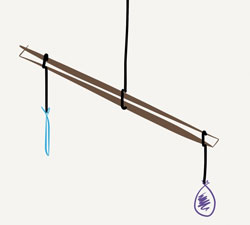Air Matters
We know that matter is something that has mass and takes up space, but is that how we would normally describe the air around us? Air has mass, but it’s hard to think of it as matter when we move through it so easily. With this experiment, you can see that air does indeed matter.
What You Need
- Two balloons
- A meter stick
- String
- Tape
- A needle

What to Do
Tie one piece of string around the center of your meter stick and tape the other end of the string to a table (you want the meter stick to be able to move easily). Blow up each balloon and tie the ends. Now, tie a piece of string to each balloon around the knot and tie the other ends to opposite sides of the meter stick.
You should be able to adjust the positions of the balloons on the meter stick to allow the meter stick to settle horizontally. We’ve created our own balance! The horizontal meter stick shows that the weight on each side is balanced.
Now, use the needle to poke a small hole in one balloon. (Be careful not to pop the balloon - we want to create a slow leak, not an explosion!) Watch what happens to the meter stick as the air leaks out of one balloon.

What's Going On?
You should see that as the air leaks out of one balloon, that side of the meter stick rises. This is because the mass weighing down one side of the meter stick is decreasing as the air leaks out and the air disperses.
But there's more to this experiment than just the mass of the air in the balloon. You'll notice that the balloons hanging on the meter stick are hanging down toward the Earth. This is because the air inside both balloons is slightly more dense than the air surrounding our experiment.
Archimedes' principle tells us that the upward buoyant force on the balloon is equal to the weight of the displaced air inside of it. This upward buoyant force resists the pulling force of gravity, partly explaining why the balloons fall more slowly toward the ground than other objects (air resistance also plays a role).
Following this principle, we know that the air rushing out of the popped balloon weighs slightly more than an equal volume of air in the room. As a result, the balance registers this difference in mass — the still-filled balloon still has this slightly heavier air inside of it while the other balloon's heavier air has dispersed into the room's air.
Apply It!
From our experiment we know that air takes up space — it was able to expand the balloon because of the space it requires! We also know that air has mass because the balloon with air was heavier than the balloon without air.
So by our definition of matter as something with mass that takes up space, we can see that air is matter! What other forms of matter are hard to detect? How else can you reveal that something has mass?
- Aliya Merali














